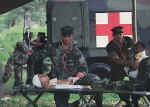Operational Obstetrics & Gynecology
Introduction
| 1st Edition | Women's Health Care | Purpose of the Manual |
| Military Medicine | Women in the Military |
 When it was written in 1992, Operational Obstetrics & Gynecology was
based primarily on my own personal experiences and perspectives, and focused on the needs
of the sea-going population.
When it was written in 1992, Operational Obstetrics & Gynecology was
based primarily on my own personal experiences and perspectives, and focused on the needs
of the sea-going population.
In writing the 2nd Edition, I have tried to incorporate several changes:
- I expanded the applicability of the manual to the other areas of military operations (Air, Sea and Land).
- I’ve added several chapters not covered in the 1st Edition.
- I’ve solicited and incorporated changes and additions from operationally experienced medical providers from the Army, Navy, Marine Corps, Air Force and Coast Guard.
 Providing health care in military settings is similar, in some ways, to
civilian settings and in some ways different.
Providing health care in military settings is similar, in some ways, to
civilian settings and in some ways different.
In civilian settings, the primary responsibility is to the patient, with secondary concerns from the insurance company, employer and family. In military settings, the primary responsibility is to the Command.
In most cases, the interests of the Command and the interests of the patient are the same, particularly in a garrison setting. In a deployed setting, divergence of interest may occasionally arise, creating challenges for the military health care provider.
Military medicine also differs from civilian medicine in three other fundamental ways:
- Medical providers are isolated.
- Medical resources are limited.
- Operational circumstances may influence the provision of medical care.
It is because of these differences that clinical problems in an operational setting may be treated differently than the same clinical problem in a civilian setting. The principles of treatment are the same: the application of treatment may be different.
 For the most part, women's health care needs are the same as men's
health care needs. Women develop coughs, colds, stomach upsets, contusions, abrasions, and
fractures. They need preventative care and immunizations.
For the most part, women's health care needs are the same as men's
health care needs. Women develop coughs, colds, stomach upsets, contusions, abrasions, and
fractures. They need preventative care and immunizations.
However, some of their health care needs are different:
- Women have some unique gynecologic and obstetric needs.
- Women may have different vulnerabilities to certain diseases or injuries.
- Women may use health care services differently than men.
Military women are a unique group.
They are a generally young, healthy population, pre-screened for most common, chronic diseases. They are, for the most part, physically fit and engage in regular exercise.
Women in the military are, as a group, younger than their male counterparts, are of lower rank, sustain more stress fractures, and utilize health care services twice as often. Even after excluding female-specific reasons (OB, GYN), they still use health care services more often. In this regard, they are similar to civilian women who also use health care services more often. In most studies, like their civilian counterparts, although they use health care services more often, they are generally less satisfied with those services than men.
Women in the military come from many backgrounds. Among Navy recruits, nearly half have been victims of physical domestic abuse prior to entry into the service, a figure similar to their male counterparts.
As a group, women have:
- More self-reported chronic conditions and all acute conditions except injuries
- Higher illness rates
- More days of illness and disability
- 10% more acute conditions, particularly infections, respiratory problems and digestive conditions
- Poorer vision
- Poorer dental status
- Better hearing
- More genitourinary problems
- Less chronic illness leading to death
- Lower death rates
About one-third of the OB-GYN health care visits made by military women are for routine care. Most of the remaining visits are for:
- STD diagnosis and treatment
- Menstrual abnormalities
- Vaginitis
- Urinary tract problems
- Pregnancy-related problems
Purpose of this Manual
This manual is designed to assist those who treat women with gynecologic problems and offer guidance for the continuing care of these women, particularly in isolated settings where gynecologic consultation is not readily available.
The manual is not all-inclusive and is not intended to replace good clinical judgment nor in-depth textbooks, which should be consulted whenever appropriate.
As in most areas of medicine, there may be more than one way to deal with any particular gynecologic problem. For simplicity, one basic approach is usually given here. There are often other approaches that will give very good or superior results.
CAPT Michael John Hughey, MC, USNR
Special Projects Officer for the Assistant Chief,
Operational Medicine and Fleet Support
Bureau of Medicine and Surgery
Department of the Navy
2300 E Street NW
Washington, DC
20372-5300
Home · Introduction · Medical Support of Women in Field Environments · The Prisoner of War Experience · Routine Care · Pap Smears · Human Papilloma Virus · Contraception · Birth Control Pills · Vulvar Disease · Vaginal Discharge · Abnormal Bleeding · Menstrual Problems · Abdominal Pain · Urination Problems · Menopause · Breast Problems · Sexual Assault · Normal Pregnancy · Abnormal Pregnancy · Normal Labor and Delivery · Problems During Labor and Delivery · Care of the Newborn
|
Bureau of Medicine
and Surgery |
Operational
Obstetrics & Gynecology - 2nd Edition |
This web version of Operational Obstetrics & Gynecology is provided by The Brookside Associates Medical Education Division. It contains original contents from the official US Navy NAVMEDPUB 6300-2C, but has been reformatted for web access and includes advertising and links that were not present in the original version. This web version has not been approved by the Department of the Navy or the Department of Defense. The presence of any advertising on these pages does not constitute an endorsement of that product or service by either the Department of Defense or the Brookside Associates. The Brookside Associates is a private organization, not affiliated with the United States Department of Defense. All material in this version is unclassified.
This formatting © 2006
Medical Education Division,
Brookside Associates, Ltd.
All rights reserved